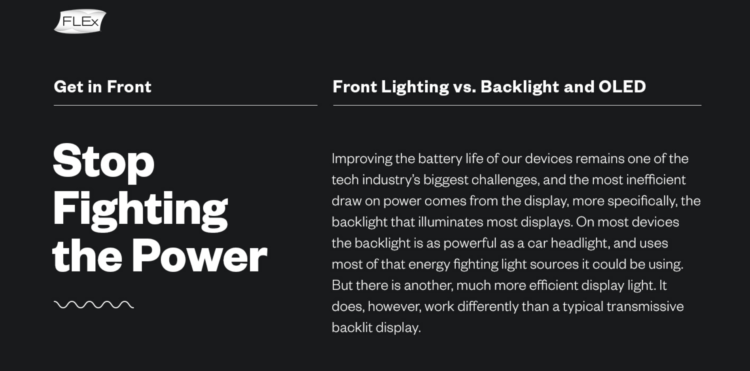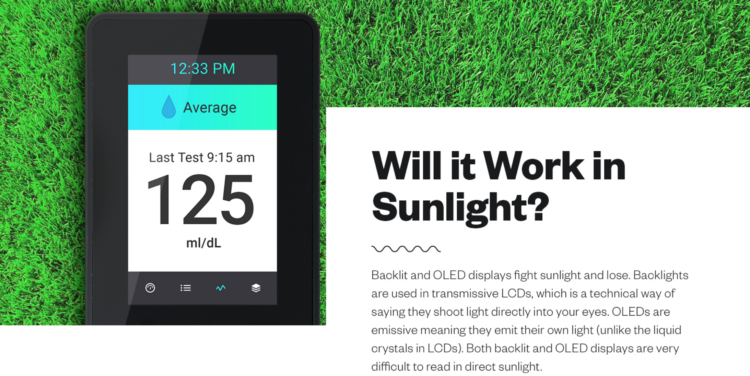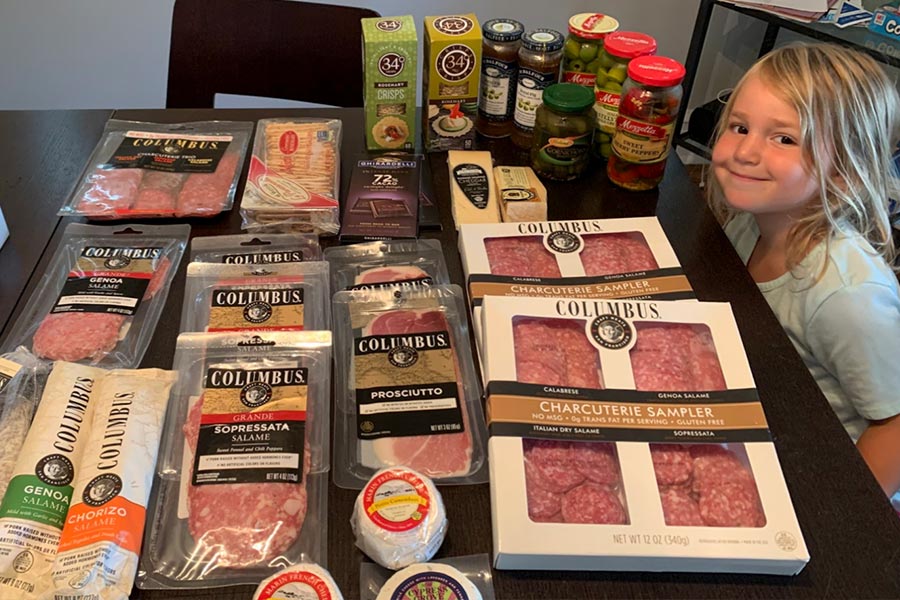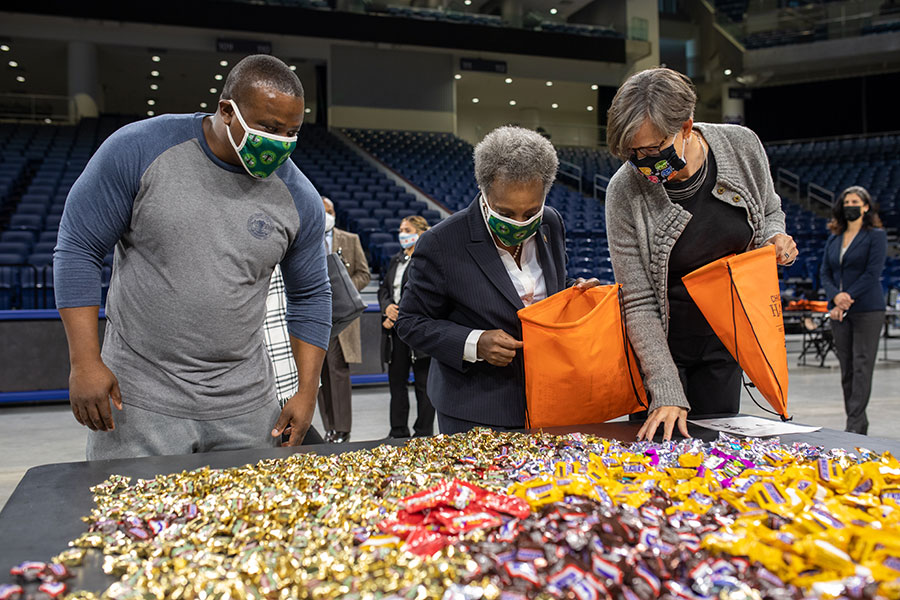“Why couldn’t they just sell tires?” was a question someone from our UX team kept asking while working out wireframes for an emerging tech client. We were all struggling with the big question: How do you map out an experience for a technology that addresses a problem people aren’t yet aware of and haven’t developed a common language for? If you work with emerging tech, this sort of thing happens a lot but here are some rules to help you keep pushing forward into exciting but uncharted territory.
First, some backstory
A client with an unhelpful name (it sounded tech-forward, but offered no hint at what they actually did) looked to us to help generate awareness around a big problem we have with our devices and how they can solve it—unfortunately it’s not a problem most people are aware of: our screens use way too much power. The display on your phone eats up about 60% of the device’s battery and it likely has a rigid backlight that wastes the majority of the light it creates (insert big frowny face).

Our client makes an ultrathin front light that bonds to the top of a device, allowing sunlight and any other ambient light to illuminate the screen, so the light only comes on when needed. It’s a big breakthrough; it could be the difference between having to charge your phone every night and having to charge it every week. But in consumer electronics, engineering changes are often driven by wow factor, and energy efficiency is a less sparkly shade of wow.
While it’s annoying to have to charge your phone every night, the consumer market wasn’t our primary target. For medical and industrial devices that monitor health and safety, battery life is more than an annoyance, it’s, well, life and death. Time spent charging means time not spent monitoring, and medical and industrial devices aren’t part of that rapid obsolescence cycle of commercial devices like smartphones. So our campaign targeted industrial and medical device makers who had a greater need for energy efficiency.
Rule 1: Define the technology in the context of the problem it solves
Our client had always defined themselves as a lighting company, but the problem it was solving wasn’t really a lighting one, and the people who were looking to get the benefits of the technology weren’t searching for a light. They were searching for power-efficiency. Our client’s technology works best with a specific type of display called Reflective LCD (or RLCD). It was a lot like a typical LCD only it didn’t have a backlight. This meant we had to talk to engineers, product designers and executives before they’d mapped out their display stacks. We weren’t selling a component. We were selling a new way to make a device, which meant we had to tell a bigger story.

“Get in Front” was the name of the campaign. And we built our messaging around technology that was “frontlit and forward-thinking” and pressed the inevitability of the technology, and how we could help engineers and designers get in front of an imminent change. Our target audience was very familiar with a backlight, but not a front light. We had to continually push the idea that a front light is a thing, and it’s the smarter place to put a light. We did this by talking about it in the context of a backlight. We had to define the new idea by what it wasn’t—the old idea—so that it could come up in searches and there was more clarity around function, and it helped to have an enemy (the backlight) to define our position.
Our agency stresses the importance that we share a mindset with our clients. We score a client’s mindset before we start working with them to ensure we’re a good fit. It may sound strange, but we go all in for our clients and this helps us do so with more confidence. This client scored well, but they pushed our idea of what a shared mindset can be.
Our creative team didn’t solve problems the same way their engineers did. We didn’t have the same instincts, but there was mutual respect. We were able to rein each other in and get out of each other’s way. It was important for our creative team to get a deeper understanding of how electronics engineers and product designers think. They tend to avoid splashy marketing materials. And if you want to disrupt their routines, you have to solve a big problem they’re interested in, but they also appreciate good storytelling just like everyone else.
Rule 2: It’s a problem even if you’re not aware of it
(But who wants to hear that?)
If you work in marketing, you’re supposed to take the word “problem” and spin it to read “opportunity”. But engineers and product designers often cringe and look away when they detect this sort of spin.

Engineers and designers are aware that screen displays are inefficient and that the tech has probably lagged because it’s not something that excites consumers. We worked from an informed idea that engineers are going to be resistant to change, at least more than designers and the folks in the C suite. It’s a lot of work for an engineer to change the way they create their display stacks. It’s also risky. This creates inertia, our sworn enemy, and the only way we were going to beat it was by demonstrating how big of a problem screens are and how they can get ahead of it: “Want to Make a Device that Holds a Charge for 5 Days?” was our most direct line aimed at all three target audiences: Engineers, product designers and executives.
Rule 3: Don’t go too micro when it comes to targeting for demand gen
While our target industries were medical and industrial device makers, we didn’t want to completely limit ourselves at this stage of awareness. We knew IoT device makers might be interested in a display that did more than blink a certain color to communicate, and that they were constrained more than other device makers by power. While IoT devices with complex displays are still in their nascent stages, we wanted to dip our toe to see what sort of reaction was there.
Microtargeting is all the rage, and it’s hard to argue with its efficiencies. But with new technologies, how certain can you be around the types of people who are going to realize all the benefits the tech can offer? Frisbees started out as pie pans! Unfortunately, that line doesn’t always work with the people who define media spends. But it’s still important to experiment with different groups and fight for this budget.
There’s a tendency at agencies to silo and see the work that other teams do as something you shouldn’t have a voice in. And while you want the experts to make the right decision, that decision still affects everyone and therefore, everyone has a vested interest and should have some sort of say. Fight for the diversity of your spend!
For this project, we wanted to reach IoT device makers who don’t typically huddle in the same spaces as our other audiences. So we did some research and discovered popular places where they’re getting information, and we pointed some ads their way. These small experiments can open up enormous opportunity for growth. It’s not always easy to sell them in, but if you don’t you’re simply not doing your job.
We Got in Front
These are the three big rules that guide us past the typical roadblocks we hit with new and emerging tech. One of the aspects of emerging tech that really energizes people on my team is the newness of everything. The blank canvas. The opportunity to explore and discover (but yes, opportunities can be problematic, depending on how you spin it). While we don’t get excited about having many rules, we need a few for traction so that we can stay in front.













